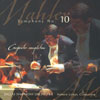Mahler Symphony No 10
A big-boned completion of Mahler’s Tenth Symphony, well performed and recorded
View record and artist detailsRecord and Artist Details
Composer or Director: Gustav Mahler
Genre:
Orchestral
Label: Delos
Magazine Review Date: 4/2003
Media Format: CD or Download
Media Runtime: 79
Mastering:
Stereo
DDD
Catalogue Number: DE3295

Tracks:
| Composition | Artist Credit |
|---|---|
| Symphony No. 10 |
Gustav Mahler, Composer
Andrew Litton, Conductor Dallas Symphony Orchestra Gustav Mahler, Composer |
Author: David Gutman
This is Mahler’s Tenth but not as we know it: Andrew Litton’s new recording is of the completion by US insurance man Clinton Carpenter. Coming hard on the heels of Robert Olson’s account of the realisation by Joseph Wheeler, it will probably confirm what most Mahlerians know already. Which is that Deryck Cooke’s performing version is both the safest and the subtlest of available options, always assuming you believe in the viability of a five-movement Tenth.
I won’t rerun all the arguments surrounding Mahler’s unfinished symphony, except to suggest that the wider dissemination of rival editions can serve as a useful reality check. For all we know, Luciano Berio’s new conclusion for Puccini’s Turandot may yet supplant the best inventions of Franco Alfano. And where there was once only the gospel according to Franz Xaver Süssmayr, we now have a range of alternative Mozart Requiems. Time may or may not settle the debate.
All this is by way of preamble to admitting that I don’t care for what Clinton Carpenter has done here. Out goes the patient and informed scholarship of Cooke and his associates; in comes the merely speculative. Litton conducts a flexible, would-be idiomatic performance with key moments lovingly nuanced, for all that some of his tempi feel sluggish. Even in the Adagio, the added clutter raises more questions than it answers. Why the minatory woodwind squawk and significant drum-roll? What is the function of the cymbal crash that caps the second statement of the famous nine-note dissonance?
The urge to ‘complete’ rather than render performable – ie to fill out textures and add contrapuntal layers not implied by Mahler himself – will not be to everyone’s taste. And, in the rest of the symphony, that urge is given free rein. The result is big-band, big-boned, rather muddle-headed Mahler – not at all what the composer was about in his last years.
Litton himself is disarmingly honest about his decision to include Carpenter’s score in his cycle. Having decided at the eleventh hour not to follow Bernstein in eschewing altogether movements 2-5, he now believes that if you have the audacity to complete a work by a great genius, you might as well ‘go for it’. Whatever your take on this, he certainly reaffirms his own orchestra-building credentials, while Delos offers another exceptional Andrew Keener production. The muffled thuds at the start of the finale (most interpreters have gone for hair-raising thwacks) are wonderfully well caught and, all in all, there’s plenty here for non-purists to admire.
Completists will be looking for a chance to hear yet another realisation, that by the Russian conductor Rudolf Barshai. Less committed readers will do well to stick with Sir Simon Rattle
I won’t rerun all the arguments surrounding Mahler’s unfinished symphony, except to suggest that the wider dissemination of rival editions can serve as a useful reality check. For all we know, Luciano Berio’s new conclusion for Puccini’s Turandot may yet supplant the best inventions of Franco Alfano. And where there was once only the gospel according to Franz Xaver Süssmayr, we now have a range of alternative Mozart Requiems. Time may or may not settle the debate.
All this is by way of preamble to admitting that I don’t care for what Clinton Carpenter has done here. Out goes the patient and informed scholarship of Cooke and his associates; in comes the merely speculative. Litton conducts a flexible, would-be idiomatic performance with key moments lovingly nuanced, for all that some of his tempi feel sluggish. Even in the Adagio, the added clutter raises more questions than it answers. Why the minatory woodwind squawk and significant drum-roll? What is the function of the cymbal crash that caps the second statement of the famous nine-note dissonance?
The urge to ‘complete’ rather than render performable – ie to fill out textures and add contrapuntal layers not implied by Mahler himself – will not be to everyone’s taste. And, in the rest of the symphony, that urge is given free rein. The result is big-band, big-boned, rather muddle-headed Mahler – not at all what the composer was about in his last years.
Litton himself is disarmingly honest about his decision to include Carpenter’s score in his cycle. Having decided at the eleventh hour not to follow Bernstein in eschewing altogether movements 2-5, he now believes that if you have the audacity to complete a work by a great genius, you might as well ‘go for it’. Whatever your take on this, he certainly reaffirms his own orchestra-building credentials, while Delos offers another exceptional Andrew Keener production. The muffled thuds at the start of the finale (most interpreters have gone for hair-raising thwacks) are wonderfully well caught and, all in all, there’s plenty here for non-purists to admire.
Completists will be looking for a chance to hear yet another realisation, that by the Russian conductor Rudolf Barshai. Less committed readers will do well to stick with Sir Simon Rattle
Discover the world's largest classical music catalogue with Presto Music.

Gramophone Digital Club
- Digital Edition
- Digital Archive
- Reviews Database
- Full website access
From £8.75 / month
Subscribe
Gramophone Full Club
- Print Edition
- Digital Edition
- Digital Archive
- Reviews Database
- Full website access
From £11.00 / month
Subscribe
If you are a library, university or other organisation that would be interested in an institutional subscription to Gramophone please click here for further information.




